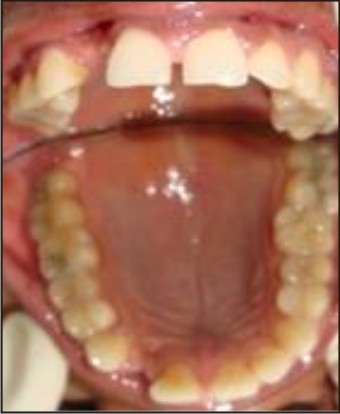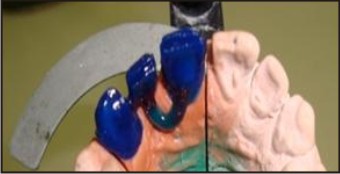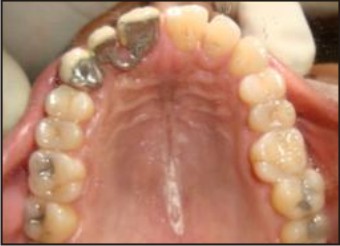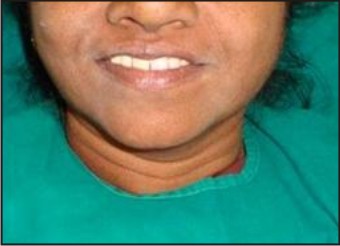Introduction
A very common aesthetic challenge seen by many clinicians is the presence of diastemata or spacing between teeth. These diastemata can be localized or generalized and are difficult to maintain when a fixed dental prosthesis is required. The etiology of a diastema is varied and ranges from a normal finding in children to pathological conditions such as supernumerary teeth, mesiodens, cysts, fibromas and pathological migration due to periodontal disease[1]. The most common factors causing midline diastema are dentoalveolar discrepancy and excessive vertical overlap of the incisors[2]. When a patient is insistent on maintaining a diastema then one of the treatment options for a missing maxillary anterior tooth is a fixed dental prosthesis with a loop connector. A loop connector is on the lingual side of a fixed dental prosthesis that serves to connect adjacent retainers and/or pontics[3].
Case Report
A 45-year old female patient reported to the Department of Prosthodontics with a chief complaint of a missing upper front tooth. Her main concern was the replacement of the missing tooth in addition to maintaining the diastema. On intraoral examination, the maxillary right lateral incisor was found to be missing and the edentulous space was found to be greater than the width of the lateral incisor in the contralateral arch (Fig 1). Two treatment options were provided to the patient; that of an implant supported restoration and a fixed dental prosthesis. The patient opted for the latter. Hence a three-unit porcelain-fused-to-metal fixed dental prosthesis was planned, using the right maxillary central incisor and canine as abutments.
 | Fig. 1 : Intraoral view
 |
Procedure
In the first appointment, radiographs and diagnostic impressions were made using irreversible hydrocolloid (Plastalgin, Septodont). The resulting diagnostic casts were prepared for a mock-up of the final restorations and this was used to explain the procedure to the patient. Next, tooth preparation was done on the abutment teeth; sufficient clearance of 1.00 mm was provided on the palatal aspect keeping the loop connectors in mind (Fig 2). A rubber base impression (Aquasil, Dentsply Int.) was made using the two stage putty reline technique and bite registration records were obtained. The impressions were poured with Type IV dental stone (Kalrock, Kalabhai). A facebow transfer was done and the casts were mounted on a semi adjustable articulator (Hanau Wide-Vue). A provisional restoration was fabricated and cemented using non-eugenol cement (Integrity, Dentsply).
 | Fig. 2 : Tooth preparation w.r.t. 11 and 13
 |
A 0.5mm thick wax sheet was lined on the maxillary cast in the edentulous area so as to create a space for oral hygiene maintenance. Wax patterns were fabricated using blue inlay wax and the loop connector was fabricated using sprue wax (Fig 3). Phosphate-bonded investment (Bellawest, BEGO) was used to invest the wax pattern and casting was done using a base metal alloy (Wiron 99, BEGO). Metal try-in was performed, (Fig 4) following which the porcelain facing (Vita, Germany) was fired according to the manufacturer’s recommendations. Occlusal correction was performed wherever necessary. After glazing, polishing and sandblasting the intaglio surface of the retainers, cementation of the fixed dental prosthesis was done using Type I Glass Ionomer Cement (Fig 5 and 6). The patient was given instructions on how to maintain oral hygiene especially in the region of the loop connector. The use of dental floss and an interdental brush were advised. The patient was recalled after 7 days to evaluate the oral hygiene maintenance.
 | Fig. 3 : Wax pattern fabrication
 |
 | Fig. 4 : Metal Try-in
 |
 | Fig. 5 : 3- unit PFM Fixed Dental Prosthesis with loop connector
 |
 | Fig. 6 : Post cementation view
 |
Discussion
Connectors are the components of a partial fixed dental prosthesis or splint that join the individual retainers and pontics together. They can be rigid or non-rigid. Rigid connectors are further classified as cast connectors, soldered connectors and loop connectors[3]. The presence of missing teeth and diastema in the anterior maxillary region pose a challenging esthetic problem in maintaining the correct mesiodistal width of the pontic. In this case, the patient was keen on maintaining the diastema between the central incisor and lateral incisor.
Loop connectors can be fabricated from sprue wax as it is circular in cross-section and easy to clean, or from a platinum-gold-palladium alloy wire[4],[5]. A connector should be designed to prevent plaque accumulation and prevent periodontal breakdown and sufficient access should also be provided for oral hygiene aids.
Another variant of the loop connector is the spring cantilever FDP which is used when the posterior abutments are sound and are used to replace a maxillary anterior tooth with diastema. But this connector produces displacement of the pontic, discomfort and interference with speech[6]. Therefore, the loop connector is a better choice. A resin bonded FDP is also another option when there is a single missing anterior tooth[7]. The prosthesis design may sometimes interfere with oral hygiene maintenance and also in speech especially with linguopalatal sounds[8]. Hence keeping the loop size small as well as rounded in cross section is of utmost importance. The patient should also be given adequate oral hygiene maintenance instructions especially in not contacting the tip of the tongue into the space between the loop and the mucosa[5].
Conclusion
A fixed dental prosthesis with a loop connector is an alternative to restoring an edentulous area with diastema. It is aesthetic but can be a slightly difficult region to maintain adequate plaque control. Following meticulous treatment planning as well as laboratory design will ensure that this fixed dental prosthesis has a successful form as well as function.
References
1. Bhandari S, Bakshi S. Survival and complications of unconventional fixed dental prosthesis for maintaining diastema and splint pathologically migrated teeth: A case series up to 8 years follow-up. Indian J Dent Res 2013; 24:375-80
2. Oesterle LJ, Shellhart WC. Maxillary midline diastemas: A look at the causes. J Am Dent Assoc 1999;130:85-94.
3. Rosenstiel, Land, Fujimoto. Contemporary Fixed Prosthodontics. 4th ed. St.Louis (Missouri). Elsevier: 2008.
4. Kamalakanth S, Arbaz S. Anterior loop connector fixed partial denture: A simple solution to a complex prosthodontic dilemma. Journal of Indian Prosthodontic Society. 2008; 8:162-4.
5. Sharma N, Paleka U, Sharma S. Loop connector - bridging the gaps…..a case report. NJDSR. 2012;1:42-5
6. Taggart J. Resin bonded spring cantilever bridge. Restorative dentistry. 1990;6:4-5
7. Dandekeri SS, Dandekeri S. Single Anterior Tooth Replacement by a Cast Lingual Loop Connector - A Conservative Approach. Journal of Clinical and Diagnostic Research. 2014; 8:9: 7-8
8. Kalra A, Gowda M E, Verma K. Aesthetic rehabilitation with multiple loop connectors. Contemporary Clinical Dentistry 2013; 4 :1: 112-15.
|